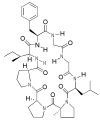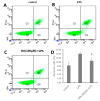Heterophyllin B Ameliorates Lipopolysaccharide-Induced Inflammation and Oxidative Stress in RAW 264.7 Macrophages by Suppressing the PI3K/Akt Pathways
- PMID: 29561811
- PMCID: PMC6017815
- DOI: 10.3390/molecules23040717
Heterophyllin B Ameliorates Lipopolysaccharide-Induced Inflammation and Oxidative Stress in RAW 264.7 Macrophages by Suppressing the PI3K/Akt Pathways
Abstract
Heterophyllin B (HB), an active cyclic peptide, is a compound existing in the ethyl acetate extract of Pseudostellaria heterophylla (Miq.) Pax and exhibited the activity of inhibiting the production of NO and cytokines, such as IL-1β and IL-6, in LPS-stimulated RAW 264.7 macrophages. In addition, HB suppressed the production of ROS and the apoptosis induced by LPS in RAW 264.7 macrophages. The underlying mechanism was investigated in the LPS-induced RAW 264.7 cells. The results showed that HB decreased the level of IL-1β and IL-6 expression by qRT-PCR analysis. HB up-regulated the relative ratio of p-AKT/AKT and p-PI3K/PI3K as indicated by western blot analysis. In summary, HB inhibited the LPS-induced inflammation and apoptosis through the PI3K/Akt signaling pathways and represented a potential therapeutic target for treatment of inflammatory diseases.
Keywords: Heterophyllin B; anti-apoptosis; anti-inflammatory effect; anti-oxidative effect.
Conflict of interest statement
The authors declare that there are no conflict of interest.
Figures









Similar articles
-
Diterpenoid trigonoreidon B isolated from Trigonostemon reidioides alleviates inflammation in models of LPS-stimulated murine macrophages and inflammatory liver injury in mice.Biomed Pharmacother. 2018 May;101:961-971. doi: 10.1016/j.biopha.2018.02.144. Epub 2018 Mar 22. Biomed Pharmacother. 2018. PMID: 29635906
-
Curcumin alleviates lipopolysaccharide induced sepsis and liver failure by suppression of oxidative stress-related inflammation via PI3K/AKT and NF-κB related signaling.Biomed Pharmacother. 2016 Oct;83:302-313. doi: 10.1016/j.biopha.2016.06.036. Epub 2016 Jul 7. Biomed Pharmacother. 2016. PMID: 27393927
-
Schisandrin A suppresses lipopolysaccharide-induced inflammation and oxidative stress in RAW 264.7 macrophages by suppressing the NF-κB, MAPKs and PI3K/Akt pathways and activating Nrf2/HO-1 signaling.Int J Mol Med. 2018 Jan;41(1):264-274. doi: 10.3892/ijmm.2017.3209. Epub 2017 Oct 25. Int J Mol Med. 2018. PMID: 29115385 Free PMC article.
-
An ethanol extract of Aster yomena (Kitam.) Honda inhibits lipopolysaccharide-induced inflammatory responses in murine RAW 264.7 macrophages.Biosci Trends. 2017 Mar 22;11(1):85-94. doi: 10.5582/bst.2016.01217. Epub 2017 Feb 7. Biosci Trends. 2017. PMID: 28179600
-
Quercetin disrupts tyrosine-phosphorylated phosphatidylinositol 3-kinase and myeloid differentiation factor-88 association, and inhibits MAPK/AP-1 and IKK/NF-κB-induced inflammatory mediators production in RAW 264.7 cells.Immunobiology. 2013 Dec;218(12):1452-67. doi: 10.1016/j.imbio.2013.04.019. Epub 2013 May 9. Immunobiology. 2013. PMID: 23735482
Cited by
-
The role of cGAS-STING signaling in pulmonary fibrosis and its therapeutic potential.Front Immunol. 2023 Oct 25;14:1273248. doi: 10.3389/fimmu.2023.1273248. eCollection 2023. Front Immunol. 2023. PMID: 37965345 Free PMC article. Review.
-
Chemical Properties, Preparation, and Pharmaceutical Effects of Cyclic Peptides from Pseudostellaria heterophylla.Molecules. 2025 Jun 9;30(12):2521. doi: 10.3390/molecules30122521. Molecules. 2025. PMID: 40572486 Free PMC article. Review.
-
The Potential Role of Cyclopeptides from Pseudostellaria heterophylla, Linum usitatissimum and Drymaria diandra, and Peptides Derived from Heterophyllin B as Dipeptidyl Peptidase IV Inhibitors for the Treatment of Type 2 Diabetes: An In Silico Study.Metabolites. 2022 Apr 24;12(5):387. doi: 10.3390/metabo12050387. Metabolites. 2022. PMID: 35629891 Free PMC article.
-
Acorus gramineusand and Euodia ruticarpa Steam Distilled Essential Oils Exert Anti-Inflammatory Effects Through Decreasing Th1/Th2 and Pro-/Anti-Inflammatory Cytokine Secretion Ratios In Vitro.Biomolecules. 2020 Feb 19;10(2):338. doi: 10.3390/biom10020338. Biomolecules. 2020. PMID: 32093087 Free PMC article.
-
Immunomodulatory Activity of Low Molecular-Weight Peptides from Nibea japonica in RAW264.7 Cells via NF-κB Pathway.Mar Drugs. 2019 Jul 8;17(7):404. doi: 10.3390/md17070404. Mar Drugs. 2019. PMID: 31288466 Free PMC article.
References
-
- Cheng B.C.Y., Ma X.Q., Kwan H.Y., Tse K.W., Cao H.H., Su T., Shu X., Wu Z.Z., Yu Z.L. A herbal formula consisting of Rosae Multiflorae Fructus and Lonicerae Japonicae Flos inhibits inflammatory mediators in LPS-stimulated RAW 264.7 macrophages. J. Ethnopharmacol. 2014;153:922–927. doi: 10.1016/j.jep.2014.02.029. - DOI - PubMed
-
- Ning-Hua T., Jun Z., Chang-Xiang C., Shou-Xun Z. Cyclopeptides from the roots of Pseudostellaria heterophylla. Phytochemistry. 1993;32:1327–1330. doi: 10.1016/S0031-9422(00)95114-8. - DOI
MeSH terms
Substances
LinkOut - more resources
Full Text Sources
Other Literature Sources

